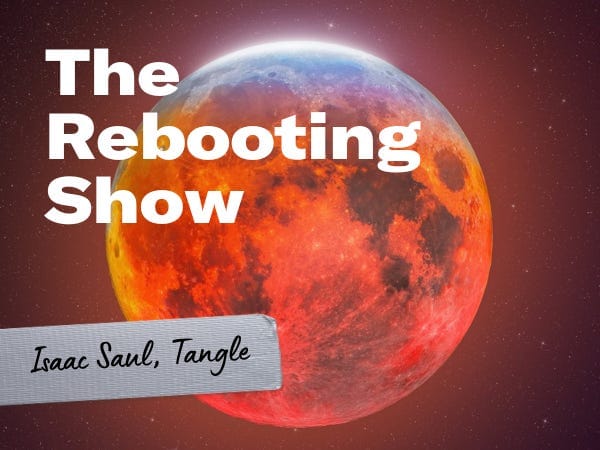Finding middle ground
Tangle's Isaac Saul bets many want non-partisan news
Couple of quick requests: If you haven’t already, please fill out my audience survey. This helps inform the product and show potential sponsors the upside of working together. (On that note, get in touch about sponsorship opportunities for December and next year.) Also, if you’re finding The Rebooting worthwhile, share it with others.
Thanks to Omeda for sponsoring this week’s issue. Check out their new Email Engagement Report to understand why you need to pay more attention to click-through rate than open rate to judge the health of your newsletters.


Newsletters are the new homepage. But we regularly hear we’re at peak newsletter. Omeda, the full-stack marketing technology platform for managing first-party data, analyzed over 1.7 billion emails its client sent in the third quarter. According to the Omeda Email Engagement Report, open rates have normalized one year into Apple’s Mail Privacy Protection rollout. Unique open rates rise by only 1.1% percent in Q3 2022, compared to 6.6% in Q2 2022 and 36.6% in Q1 2022. Click rates, which plummeted after the introduction of MPP, have seen a slight uptick to an average of 4.6%. Find out how your newsletter measures up – and how to measure success in a post-MPP environment.


How Tangle tackles non-partisan news
On this week’s episode of The Rebooting Show, I spoke to Isaac Saul, founder of Tangle, a subscription-based non-partisan politics newsletter. Listen to The Rebooting Show on Apple Podcasts or Spotify.
As Americans go to the polls today for the midterm elections, it’s safe to say American politics have never been more divided and divisive at least in modern times. Conservatives do not trust anything in The New York Times, progressives do not trust anything from Fox News. Nuance has seemingly been lost in most flame wars. The old struggle to be fair and balanced has given way to preaching to the choir.
Isaac Saul saw this first hand as a political journalist at outlets like Huffington Post, where what he wrote would end up being distrusted based on the place it appeared rather than the substance. Three years ago, Isaac started Tangle with the idea that presenting both sides to news stories would appeal to a wide group of people. And that’s proven true. Today Tangle has 8,000 paying subscribers and nearly 50,000 free email subscribers – a 16% conversion rate is amazing. It is launching a new ad program to complement the $30,000 a month in recurring revenue it takes in.
Like Semafor, Tangle has its own spin on deconstructing the atomic unit of news, aka the news article. Tangle separates out the factual presentation of the issue, before presenting the view from the left, the view from the left, and then Isaac’s viewpoint. This is hard to pull off, particularly with issues like affirmative action, Covid-era school closures, and, of course, all things Trump.
“I am pretty politically incongruent. I try to go and understand, as a politics reporter, what's happening in the world. In order to get a balanced view of any single story, I would have to read 10 publications that have clear, diametrically opposed political leaning. I can't just read the New York Times. I have to read the New York Times news section and then go read the Wall Street Journal if I really want to get this full picture. And so I was like, there have to be other people like me out there. I figured if I could put all that stuff in one place, a lot of sort of politically open-minded people would read it.”
What I like about Tangle is that it’s open minded without falling into the trap of bothsiderism. The shift to “fact check” journalism hasn’t worked. The extreme partisanship of news coverage, whether overt or institutional, hasn’t worked. I think part of the way out of this is simply approaching these fraught issues with, if not an open mind on all issues, a willingness to be wrong. Nobody has everything figured out, and those who act like they do are either psychopaths or liars.
Thanks to Jay Sparks of PodHelp us for producing this podcast. Please send me your feedback. My email is bmorrissey@gmail.com.


Twitter’s subscription plans
As I wrote last week, consumer tech platforms and the advertising industry have made for odd bedfellows. Silicon Valley’s conception of advertising is a particular kind: data-focused, direct response. Elon Musk’s early moves at Twitter have certainly betrayed an indifference to the concerns of the ad industry, even cheekily threatening them with retribution for pulling ad spending. Casey Newton reports that Musk is even considering a plan that will shift Twitter’s business model to subscriptions. This is part of a long-term decoupling of consumer tech from the ad industry that I discussed with Troy Young in the latest episode of the People vs Algorithms podcast. Listen on Apple Podcasts and Spotify.

Recommendations
I still have my doubts about Substack’s app strategy, but I’m intrigued by its new chat feature, which could prove a better way of adding a virtual community feature beyond hacking Slack or dealing with the insanity of Discord. The feature is iOS-only at this point, so if you have an iPhone, you’ll need to download the Substack app and go to the chat feature. I’m hoping to use it as a place for discussion to make the newsletter more two-way.
Efficiency is nearly undefeated when it comes to digital media. For now, the value created by hand-crafted newsletter ads makes up for the friction that’s usually seen as a mortal enemy. Thanks to Mark Stenberg for including me in this piece.
Making decisions means you’ll be wrong sometimes, but that’s no excuse for putting off making a call. The hysteria surrounding Musk’s rushed moves at Twitter perhaps loses sight of the fact that acting with a sense of urgency – and without fearing an imperfect decision – has a lot of value.
Layoffs are nearly impossible to get right. Cutting a big chunk of staff is challenging for the most well-run companies. It’s no surprise that Twitter, notoriously chaotic with a new famously chaotic owner, has made a shitshow of eliminating half the positions at the company. In contrast, Stripe appears to have taken a far more measured and human approach.
Performance marketing is seductively simple: get profitable returns immediately. Who wouldn’t want that? Most things are more complicated, including how people make decisions. Airbnb is turning into an interesting test case of a big company that’s rebalanced its spending from direct response ads like search in favor of brand building. So far, it sees the shift working.
Humility is an underrated trait in dealing with an unpredictable and complex world. The truest cliche is that nobody has it all figured out, although our current information environment tends to reward strongly held loose opinions. Semafor’s Ben Smith and Derek Thompson had a good conversation about how an essential quality for journalists Semafor is looking to hire is the humility to recognize their views might be wrong. Go figure.

Resources
If you’re building a newsletter, Beehiiv is putting together a weeklong course focused on growing and making money from newsletters. The course runs Dec. 4-8. There’s a great lineup of speakers, including Workweek’s Adam Ryan, Morning Brew’s Alex Lieberman and Puck’s Max Tcheyan. (I’m also giving a talk.) Check it out and apply to join.
The News Product Alliance is looking for a new member of its board of directors. The application deadline is Nov. 27. More information here.
The CUNY j-school put together a good set of resources for those journalists taking the independent path, including everything from growth to pricing to staying sane.
Last week, I spoke at the Piano Academy about not losing sight of the human touch in building subscriptions businesses. You can see the full day of programming.
Interested in events from The Rebooting? Fill out this form for invites.

Thanks for reading. Send me feedback: bmorrissey@gmail.com




